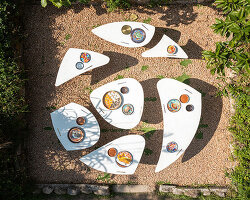a research team led by the morphing matter lab at carnegie mellon university in the USA was inspired by how furniture is flat packed to save packaging space and carbon footprint during transportation to develop flat pasta that turns into 3D shapes when cooked. the team introduced tiny grooves into flat pasta dough, made of only semolina flour and water, in patterns that make it morph into tubes, spirals, twists, and waves when cooked.

images courtesy of carnegie mellon university
the team developed a groove-based shape morphing technique that can make many types of materials, specially edible ones such as authentic italian pasta, flat-packed, and morph when cooked. the plastic material, used in food packaging, is a major contributor to landfills in the united states so finding effective food packaging strategies is crucial to maintaining a sustainable future. the concept of morphing food that can reduce packing space during transportation and storage.

morphing structures are often engineered with mechanisms that cannot be applied to morphing food, as food material composition is subject to many constraints, associated with nutritional requirements or culinary culture. to fulfill these functional requirements of food, the researchers introduced a simple and universal diffusion-based mechanism to enable a transient morphing effect in structures with parametric surface grooves. the grooves can be realized with a single material and fabricated using low-cost manufacturing methods, such as stamping, molding, and casting.
the authors demonstrated from quantitative experiments and multiphysics simulations that parametric surface grooving can induce temporary asynchronous swelling or deswelling and can transform flat objects into designed, three-dimensional shapes. for 3d-shaped pasta like macaroni, more than 60% of the packaging space is used to pack air. by making flatpack pasta, a large portion of the packaging space for food is saved.

further, the shape of food will also impact the carbon footprint during the cooking process. they discovered that in italy, 0.7% to 1% of greenhouse gas emissions is due to cooking pasta, and these emissions could be reduced by half if the shape and cooking processes could be optimized. they believe that the development of a comprehensive guiding design principle is important for others outside of the scientific field, such as chef and food manufacturers, to create their own unique morphing food with a broadened categories of food materials including different wheat flours, gluten-free materials, and food gels.

in their newly published paper titled ‘morphing pasta and beyond’ featured as a cover story in the may issue of science advances, the researchers explained the underlining morphing mechanism through quantitative design and analysis. they also believe that the space-saving feature of flat-packed food becomes even more critical for contexts including hiking trips, disaster site food delivery, or space travels. so they conducted a field test by carrying and cooking the flat-packed pasta during a hiking trip and were able to successfully cook the helical morphing pasta with a portable cooker.






project info:
name: morphing pasta and beyond
designboom has received this project from our ‘DIY submissions‘ feature, where we welcome our readers to submit their own work for publication. see more project submissions from our readers here.
edited by: yasmina karam | designboom











